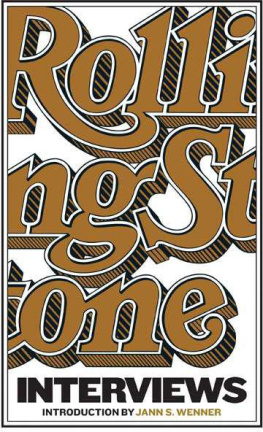Thank you for downloading this Simon & Schuster ebook.
Get a FREE ebook when you join our mailing list. Plus, get updates on new releases, deals, recommended reads, and more from Simon & Schuster. Click below to sign up and see terms and conditions.
CLICK HERE TO SIGN UP
Already a subscriber? Provide your email again so we can register this ebook and send you more of what you like to read. You will continue to receive exclusive offers in your inbox.
We hope you enjoyed reading this Simon & Schuster ebook.
Get a FREE ebook when you join our mailing list. Plus, get updates on new releases, deals, recommended reads, and more from Simon & Schuster. Click below to sign up and see terms and conditions.
CLICK HERE TO SIGN UP
Already a subscriber? Provide your email again so we can register this ebook and send you more of what you like to read. You will continue to receive exclusive offers in your inbox.

Simon & Schuster
1230 Avenue of the Americas
New York, NY 10020
www.SimonandSchuster.com
Copyright 2006, 2017 by Wenner Media, LLC
All rights reserved, including the right to reproduce this book or portions thereof in any form whatsoever. For information, address Simon & Schuster Subsidiary Rights Department, 1230 Avenue of the Americas, New York, NY 10020.
First Simon & Schuster hardcover edition October 2017
SIMON & SCHUSTER and colophon are registered trademarks of Simon & Schuster, Inc.
For information about special discounts for bulk purchases, please contact Simon & Schuster Special Sales at 1-866-506-1949 or .
The Simon & Schuster Speakers Bureau can bring authors to your live event. For more information or to book an event, contact the Simon & Schuster Speakers Bureau at 1-866-248-3049 or visit our website at www.simonspeakers.com.
Interior design by Lewelin Polanco
Jacket Design By Milton Gl Aser, Inc.,
Adapted from his Original Poster Created In 1966;
Back Jacket Photo Jerry Schatzberg/ Trunk Archive
Title page design by Milton Glaser, Inc., adapted from his original poster created in 1966.
Library of Congress Cataloging-in-Publication Data is available.
ISBN: 978-1-5011-7319-6
ISBN: 978-1-5011-7320-2 (ebook)
Introduction
No single event can awaken within us a stranger totally unknown to us. To live is to be slowly born.
ANTOINE DE SAINT-EXUPRY, FLIGHT TO ARRAS
It may have been a slow time coming, but one day in 1960, when he was nineteen years old, Robert Allen Zimmerman of Duluth and Hibbing, Minnesotathe elder of two sons of Abraham and Beatrice Zimmermandecided to make a name for himself, as well as a nascent identity, a self, and a fantasticated life story nearer to his hearts desire. (This may have been a slow but not totally calculated decision: As he told People magazine in 1975, I didnt consciously pursue the Bob Dylan myth. It was given to me by God. Inspiration is what were looking for. You just have to be receptive to it.)
Bob Dylan, he volunteered to his early interviewers, was raised in Gallup, New Mexicohe often said, I dont have a family, Im all aloneand was a child of the open road, having run away from home seven timesat ten, twelve, thirteen, fifteen, fifteen-and-a-half, seventeen, and eighteen. His peregrinations took him to North and South Dakota, Kansas, Texas, California (where at age ten, he claimed to have seen Woody Guthrie perform in Burbank), and even Mexico, thumbing rides and riding freight trains. I danced my way from the Indian festivals in Gallup, New Mexico/To the Mardi Gras in New Orleans, Louisiana, he wrote in his early autobiographical sketch My Life in a Stolen Moment. He traveled with a carnival off and on for six years, he confided to the folksinger Cynthia Gooding in 1962. I was clean-up boy. I was mainliner on the Ferris wheel. Do the shoreline thing. Use to do all kinds of stuff like that. As he told the New York Herald Tribune in 1965, My past is so complicated you wouldnt believe it, man.
His life story changed as he proceeded onward in his journey, as, remarkably, did his physiognomy and everyday appearance. Like the Greek sea deity Proteus, who in order to elude his pursuers continually shape-shifted from dragon to lion to fire to flooduttering prophecies along the wayBob Dylan, in his early days, had, according to the folksinger Eric von Schmidt, the most incredible way of changing shape, changing size, changing looks. The whole time... he wore the same thing, his blue jeans and cap. And sometimes he would look big and muscular, and the next day hed look like a little gnome, and one day hed be kind of handsome and virile, and the following day hed look like a thirteen-year-old child. It was really strange. (One thinks of the advice once given by the ancient Greek elegiac poet Theognis: Present a different aspect of yourself to each of your friends.... Follow the example of the octopus with its many coils which assumes the appearance of the stone to which it is going to cling. Attach yourself to one on one day and, another day, change color. Cleverness is more valuable than inflexibility.)
You would also never know what his voice was going to sound like. One of the other fascinating, if obvious, things about Bob Dylans chameleonic personality was the way the timbre of his voice would change from one record or period of his life to anotheras if his voice, too, couldnt stand having just one unvarying sound. When he first arrived in New York City, he was singing like a hillbilly, like a dog with his leg caught in barbed wire, as someone remarked at the time. And as years went by, Dylans voice would veer from, in his words, that thin... wild mercury sound... metallic and bright gold of Blonde on Blonde (1966) to the insouciant country sound, which Dylan attributes to his having stopped smoking cigarettes, of Nashville Skyline (1969) to the openheartedness, gentleness, vulnerability, and anger of Blood on the Tracks (1975) to the haunting timbral admixture of sandpaper and sherry of Time Out of Mind (1997).
The French poet Arthur Rimbauds I is another became Dylans self-defining (selves-defining) modus vivendi. Reading a newspaper account of himself, he once remarked, God, Im glad Im not me. When asked by a reporter the reason for his wearing a wig and a fake beard at a 2003 Newport Folk Festival concert, Dylan replied, Is that me who you saw up there? In a 1977 interview I conducted with him about his film Renaldo and Clara , Dylan explained to me, Theres Renaldo, theres a guy in whiteface singing on the stage, and then theres Ronnie Hawkins playing Bob Dylan. Bob Dylan is listed in the credits as playing Renaldo, yet Ronnie Hawkins is listed as playing Bob Dylan. So Bob Dylan, I surmised, may or may not be in the film. Exactly. But Bob Dylan made the film. Bob Dylan didnt make it, he told me. I made it.
He even explored and confessed to the more particulated (some might say self-splitting) nature of his being. Have you ever felt like a couple? the playwright and actor Sam Shepard once asked him. A couple? Dylan responded. You mean two? Yeah. All the time. Sometimes I feel like ten couples. And as he informed Newsweek s David Gates: I dont think Im tangible to myself. I mean, I think one thing today and I think another thing tomorrow. I change during the course of a day. I wake and Im one person, and when I go to sleep I know for certain Im somebody else. I dont know who I am most of the time. It doesnt even matter to me. (One thinks of the Buddhist notion that the ego isnt an entity but rather a process in time, as well as of Virginia Woolfs comment in Orlando that a biography is considered complete if it merely accounts for six or seven selves, whereas a person may well have as many thousand.)
Next page









